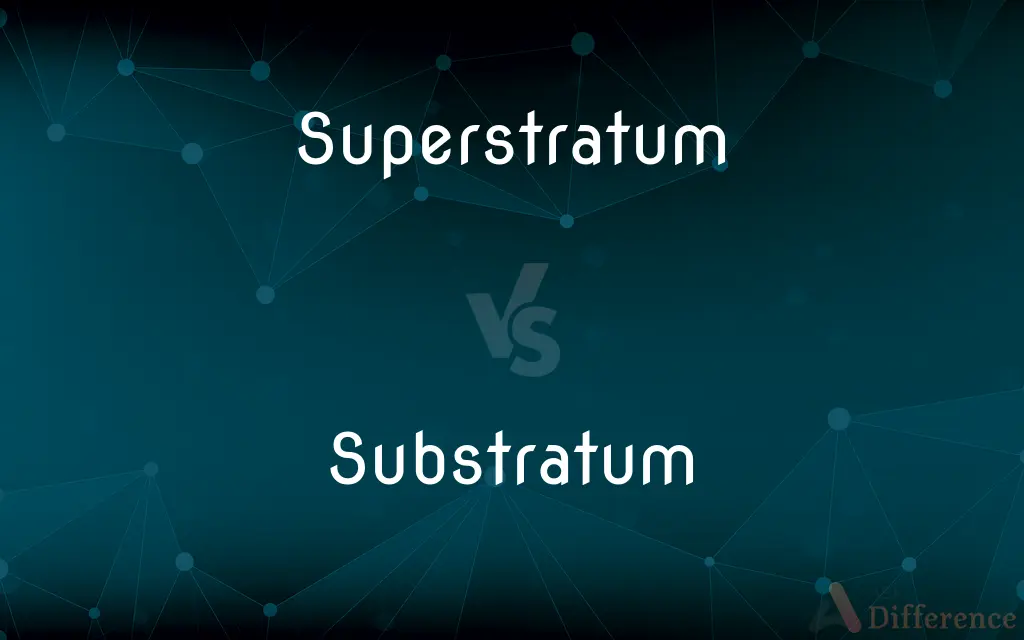Superstratum vs. Substratum — What's the Difference?
By Maham Liaqat & Urooj Arif — Updated on April 30, 2024
Superstratum refers to a language that influences another during a social dominance, focusing on vocabulary and style, while substratum affects the foundational structure of a language during minority influence.

Difference Between Superstratum and Substratum
Table of Contents
ADVERTISEMENT
Key Differences
Superstratum refers to the language of a dominant or later arriving group that influences an existing language, often affecting vocabulary and stylistic elements. On the other hand, substratum involves the language of a culturally subordinate or less powerful group impacting the dominant language, especially in terms of phonology and grammar.
Superstratum influence typically occurs when a powerful or technologically advanced culture imposes its language through colonialism, trade, or conquest. Meanwhile, substratum influence often arises from the remnants of a conquered or absorbed culture's language, subtly altering the dominant language's structure.
Languages under superstratum influence might adopt lexical and syntactical features from the superstratum language, reflecting socio-economic power dynamics. Whereas languages influenced by a substratum might integrate deeper grammatical patterns or phonetic changes, reflecting a more embedded cultural integration.
The effects of superstratum are generally more visible and acknowledged due to the social prestige of the influencing language. Conversely, substratum effects can be subtle and may only be recognized upon detailed linguistic analysis.
Superstratum impacts are often observed in the upper layers of language use, such as in formal, academic, or official discourse. In contrast, substratum influences are typically more prevalent in everyday speech and colloquialisms.
ADVERTISEMENT
Comparison Chart
Definition
Language of a socially dominant group
Language of a culturally subordinate group
Influence on Language
Affects vocabulary and style
Affects phonology and grammar
Occurrence
Through colonialism, trade, or conquest
From remnants of conquered cultures
Visibility
More visible, linked to socio-economic power
Subtle, often detected in detailed analysis
Typical Impact
Seen in formal, academic discourse
Evident in everyday speech and colloquialism
Compare with Definitions
Superstratum
A language that imposes influence due to social dominance.
French as a superstratum influenced English during the Norman conquest.
Substratum
Influence characterized by the adoption of vocabulary and style.
English technical jargon often has Germanic superstratum origins.
Superstratum
Influence characterized by the adoption of vocabulary and style.
English technical jargon often has Germanic superstratum origins.
Substratum
Affects more formal and official language use.
Legal and scientific terminologies in many languages are superstratum influences.
Superstratum
Seen in colonial, trade, or conquest scenarios.
The English language bears superstratum influences from Latin and French.
Substratum
A language that imposes influence due to social dominance.
French as a superstratum influenced English during the Norman conquest.
Superstratum
The linguistic layer reflecting higher socio-economic class.
Latin phrases in English are remnants of its superstratum past.
Substratum
The linguistic layer reflecting higher socio-economic class.
Latin phrases in English are remnants of its superstratum past.
Superstratum
Affects more formal and official language use.
Legal and scientific terminologies in many languages are superstratum influences.
Substratum
Seen in colonial, trade, or conquest scenarios.
The English language bears superstratum influences from Latin and French.
Superstratum
One layer or stratum superimposed on another.
Substratum
An underlying layer.
Superstratum
(Linguistics) The language of a later, invading people imposed on and leaving features in an indigenous language.
Substratum
A layer of earth beneath the surface soil; subsoil.
Superstratum
(geology) A stratum that is on top of another
Substratum
A foundation or groundwork.
Superstratum
(linguistics) A language imposed upon a population that previously spoke another language
Substratum
The material on which another material is coated or fabricated.
Superstratum
A stratum, or layer, above another.
Substratum
(Philosophy) The underlying characterless substance that supports attributes of material reality.
Substratum
(Biology) A substrate.
Substratum
(Linguistics) A substrate.
Substratum
A layer that lies underneath another.
Substratum
(figuratively) The underlying cause or basis of something.
Substratum
(linguistics) A substrate.
Substratum
That which is laid or spread under; that which underlies something, as a layer of earth lying under another; specifically (Agric.), the subsoil.
Substratum
The permanent subject of qualities or cause of phenomena; substance.
Substratum
Any stratum lying underneath another
Common Curiosities
Can a language have both superstratum and substratum influences?
Yes, many languages, such as English, have both types of influences due to their complex histories of conquest and cultural integration.
Why is superstratum influence more visible?
Because it often comes from dominant groups whose cultural elements are considered prestigious or advanced, making them more noticeable.
How does superstratum influence differ from substratum influence?
Superstratum typically influences vocabulary and style due to social dominance, while substratum influence alters phonology and grammar.
What is substratum?
Substratum is the language or dialect of a subordinate or absorbed group that influences the dominant language, especially in structural aspects.
How do superstratum and substratum influences affect language evolution?
They contribute to the dynamic nature of language, introducing changes in lexicon, phonology, and grammar.
Can a superstratum become a substratum over time?
In scenarios where the social or political dynamics change dramatically, the roles can reverse, although this is rare.
xWhat is superstratum?
Superstratum is the language or dialect of a socially or politically dominant group that influences another language.
Is superstratum always related to colonialism?
Not always, but it is a common scenario where a superstratum influence can be observed due to the power dynamics involved.
How do linguists identify substratum influences in a language?
Linguists analyze historical, phonetic, and grammatical evidence to identify underlying influences that may not be immediately obvious.
What role does socio-economic power play in superstratum influence?
Socio-economic power is crucial in defining which language acts as a superstratum due to its association with the dominant group.
What is an example of a superstratum influence in English?
The extensive use of French vocabulary in English legal and culinary terms is an example of superstratum influence.
Are substratum influences always subtle?
Typically, yes, because they come from less dominant cultural elements and affect deep linguistic structures.
What is an example of a substratum influence in English?
The basic grammatical structure of English, which includes aspects of Celtic languages, is a substratum influence.
Can substratum influence lead to language revitalization?
It can contribute to the retention of linguistic diversity within a dominant language, preserving certain elements of the minor language.
Share Your Discovery

Previous Comparison
Stalin vs. Lenin
Next Comparison
Liquid vs. SolidAuthor Spotlight
Written by
Maham LiaqatCo-written by
Urooj ArifUrooj is a skilled content writer at Ask Difference, known for her exceptional ability to simplify complex topics into engaging and informative content. With a passion for research and a flair for clear, concise writing, she consistently delivers articles that resonate with our diverse audience.
















































